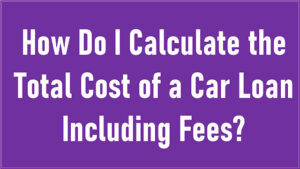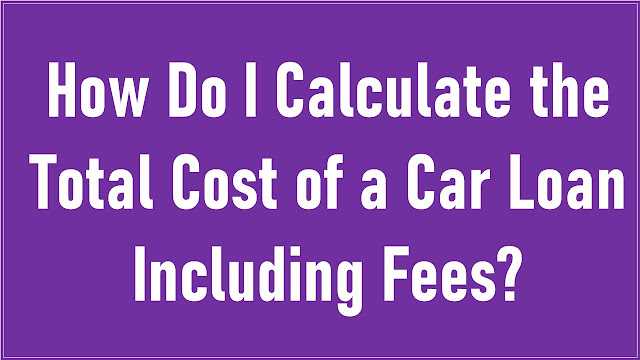
Introduction.
In this article, I’ll guide you through the essential steps to calculate the total cost of a car loan, including various fees that often lurk beneath the surface. Buying a car is a significant financial decision, and understanding the full scope of expenses is crucial to making an informed choice. While the initial price tag of a vehicle is a major consideration, it’s equally important to factor in additional costs that can significantly impact your overall financial commitment.
Car loans often come with a variety of fees, such as interest rates, origination fees, and monthly payments, which can add up over the life of the loan. By the end of this article, you’ll have a comprehensive understanding of how to assess the complete cost of your car loan, empowering you to make a well-informed decision when purchasing your next vehicle.
- Loan principal amount and interest rate determination.
- Understanding the loan term and payment frequency.
- Factoring in additional fees and charges.
- Monthly payment calculation with an example.
- Analyzing the total cost over the loan term.
- Tips for minimizing car loan expenses.
Loan Principal Amount and Interest Rate Determination.
To calculate the total cost of a car loan, you must start by understanding the loan principal amount and the interest rate. The loan principal is the initial amount you borrow to purchase the car. This is the total cost of the vehicle minus any down payment you make. The interest rate, on the other hand, is the percentage of the principal that the lender charges you as a fee for borrowing the money.
The interest rate you receive on your car loan depends on a variety of factors, including your credit score, the loan term, and the current market conditions. A higher credit score typically allows you to qualify for a lower interest rate, which can significantly impact the total cost of your car loan. So, it’s essential to shop around for the best interest rate by getting quotes from multiple lenders.
Understanding the loan principal amount and the interest rate is the foundation of calculating your car loan’s total cost. It sets the stage for determining the monthly payments and assessing the overall affordability of the loan.
Understanding the Loan Term and Payment Frequency.
The loan term and payment frequency play a vital role in determining the total cost of your car loan. The loan term is the duration over which you’ll be making payments on the loan. Car loans typically range from 36 to 72 months, with some lenders offering shorter or longer terms. Shorter loan terms usually come with higher monthly payments but lower overall interest costs, while longer terms result in lower monthly payments but higher interest costs.
Additionally, you need to consider the payment frequency, which can be monthly, bi-weekly, or weekly. The payment frequency affects how often you make payments, which, in turn, affects the total interest paid over the life of the loan. Bi-weekly or weekly payments can help you pay off the loan faster and reduce the total interest paid, as you make more frequent contributions toward the principal.
Understanding the loan term and payment frequency is crucial for evaluating your financial situation and selecting a term that aligns with your budget and financial goals. It’s a balance between affordable monthly payments and minimizing the overall cost of the loan.
Factoring in Additional Fees and Charges.
In addition to the loan principal and interest rate, it’s crucial to factor in any additional fees and charges associated with the car loan. These fees can significantly impact the overall cost of the loan. Common fees include origination fees, late payment fees, prepayment penalties, and documentation fees.
Origination fees, for instance, are charges imposed by the lender to cover the cost of processing the loan. Late payment fees are incurred if you fail to make a payment on time. Prepayment penalties, though less common nowadays, are charges for paying off the loan early.
To calculate the total cost of your car loan, you need to account for these fees over the life of the loan. This involves understanding the fee structure and considering how it affects the monthly payments and the overall affordability of the loan.
Monthly Payment Calculation with an Example.
Calculating the monthly payment is a crucial step in understanding the financial commitment of a car loan. The monthly payment includes both the principal and interest portions, which are amortized over the loan term.
A standard formula to calculate monthly payments is:
[M = frac{P times r times (1 + r)^n}{(1 + r)^n – 1}]
Where:
– (M) is the monthly payment.
– (P) is the loan principal.
– (r) is the monthly interest rate (annual interest rate divided by 12).
– (n) is the total number of payments (loan term in months).
Using this formula, you can plug in the values for your specific loan and calculate the monthly payment. For example, if you borrow $20,000 for 60 months with an annual interest rate of 5%, the monthly payment would be approximately $377.42.
Understanding how to calculate the monthly payment gives you a clear picture of what you’ll need to pay each month, making it easier to budget and plan for the loan.
Analyzing the Total Cost over the Loan Term.
To determine the total cost of the car loan, you need to analyze the cumulative payments made over the loan term, including both the principal and interest. Multiply the monthly payment by the total number of payments (loan term in months) to calculate the total amount you’ll pay over the life of the loan.
This total cost provides a comprehensive view of how much the car will actually cost you when factoring in interest and fees. It’s an essential step in making an informed decision about whether the loan is financially manageable and fits your budget.
Tips for Minimizing Car Loan Expenses.
Lastly, to minimize car loan expenses and reduce the total cost of the loan, consider the following tips: Shop Around for the Best Interest Rate: Obtain quotes from multiple lenders to secure the lowest possible interest rate based on your creditworthiness. Make a Larger Down Payment: Putting more money down upfront reduces the loan amount, resulting in lower interest charges.
Choose a Shorter Loan Term: Opt for a shorter loan term if it fits your budget, as it will reduce the total interest paid over the life of the loan. Avoid Prepayment Penalties: Select a loan that doesn’t impose penalties for paying off the loan early, giving you the flexibility to save on interest by making extra payments. Regularly Check and Improve Your Credit Score: A higher credit score can help you qualify for a lower interest rate, saving you money on interest payments over time.
Implementing these tips can significantly impact the total cost of the car loan, making it more affordable and advantageous in the long run.
Conclusion.
I hope this guide has shed light on the intricacies of calculating the total cost of a car loan, encompassing not only the principal and interest but also the various fees involved. Understanding these costs is crucial in making an informed financial decision when purchasing a vehicle. By factoring in the origination fees, application fees, and any other hidden charges, you can have a more accurate estimate of your overall financial commitment.
In conclusion, while car loans are a common means of financing a vehicle, it’s vital to delve into the fine print and consider all costs involved. This ensures you’re not caught off guard by unexpected expenses, and it empowers you to negotiate better terms or seek out more favorable loan options. Remember, being well-informed is the first step towards making a sound financial choice when it comes to buying a car.
